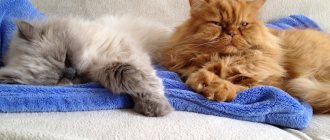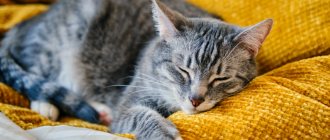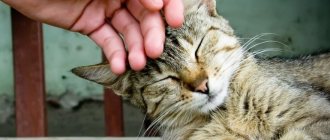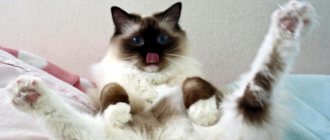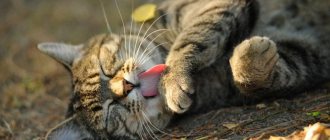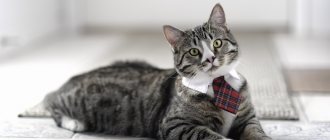Cats and cats, when they purr, can be a real elixir of health for nervous system disorders, stress and other troubles, and stroking them is a powerful relaxant, especially if you pet them. They calm much more effectively than motherwort and valerian, and their owners, who have earned the love and tenderness of their pets, experience incomparable happiness with these strange sounds that the furry ones make. Why cats purr when you pet them, what lies behind the purring and how you can determine a cat’s mood by sound. It won't hurt to understand the issue.
How does this happen and where does the sound come from?
It may seem a little ridiculous, but the mystery of a cat's purring has not yet been solved. Scientists around the world have put forward various assumptions about the origin of the cute sound. However, none of them have been proven. Zoologists are still arguing why a cat purrs and in what way.
Photo: There are many theories about the origin of cat purring
The problem is that the organ responsible for the rhythmic iridescent sounds both during exhalation and inhalation is currently unknown.
There is a version that the chirping is created due to the peculiar vibrations of the very fragile hyoid bones located near the vocal cords. Unfortunately, it was not possible to test the hypothesis.
Some felinologists believe that purring is caused by increased circulation in the blood vessels caused by the cat's emotional experiences.
This causes the chest to vibrate. and the throat of the animal. The vibrations are then transmitted to the head and resonate in the cranial sinuses.
Photo: Some theories about cat purring aren't very scientific
In ancient times, there was a misconception that cats allegedly purr with their stomachs. It is unclear how exactly such a strange theory was explained, but it spread widely among people.
There is an assumption that sound vibrations occur in the animal’s lungs during rapid inhalation and exhalation. The air inside the organs begins to vibrate, emitting a bizarre soothing “purr”.
A group of scientists believes that the cat makes such unusual sounds using rhythmic movements of the larynx.
Another assumption is based on the fact that special contractions of the cat’s diaphragm generate purring.
There is a theory that such sounds cause powerful impulses emanating from the pet’s brain.
These charges travel through the central nervous system to the muscles of the vocal cords and activate them. The vibration of the latter during inhalation and exhalation is heard by us as a purr.
But scientists from New Orleans used powerful microphones to find false vocal cords in cats. They are quite soft and elastic, which allows them to vibrate strongly and make chirping sounds.
Purring phenomenon
Throughout the history of mankind, the cat has accompanied us. Tens of thousands of years ago, the inhabitants of the Middle East tamed the wild steppe cat, and since then it has become a symbol of the hearth and home.
Due to its special unusual sound, in ancient times this animal was a symbol of fun and play, but in the Middle Ages the mysterious essence of purring began to be considered devilish and sinful.
Modern cat lovers know that their songs are not sent from heaven or hell, but are the result of a physiological process. It is not entirely clear which organ is responsible for sound; only one thing is clear – sounds are produced consciously and controlled by the animal itself.
Why or why do cats purr?
We believe that cats make this velvety sound when they experience pleasant emotions... This is true, but only partly.
It turns out that an animal can purr for many reasons, and not only when it feels good. That's what we thought!
A way to calm down
In stressful situations, cats begin to purr. This happens due to the fact that in childhood, when the mother was nearby, she would certainly purr songs to the kittens and thereby calm the tailed baby. In this way, small, adult and old cats try to calm themselves down in difficult life situations.
Have you noticed that these sounds appear at the most inopportune moment? For example, during unloved combing or, in general, at that moment when the cat is angry and bites! It turns out he does this in order to pull himself together. The sounds produced have a calming effect on them.
Advice!
Next time you pet your pet, think about it! Or maybe at this moment he doesn’t like your stroking at all?
Greetings
But our pets do not always purr when they are in a bad mood. When you come home and the cat greets you with a purr and a joyful “purr”, affectionately rubbing itself and walking with its tail, it means that it is glad to see you. Often, along with purring, cats like to hug and poke their noses in our faces. This is how they show us their love (by the way, sometimes animals can make half-meow, half-murmur noises). Well, isn't it nice?
Sound therapy
It turns out that the sound of purring is pleasant not only for humans! By using their vibration, kittens are able to recover faster and also help us in this. The low timbre of this sound improves metabolic processes, promotes the healing of wounds and abrasions, and reduces pain. It’s not for nothing that they say that a cat lies down on a sore spot to heal it! So take your furbaby and get some relaxing sound therapy!
Charger
Cats get a lot of rest (which is why it is so important to provide a decent home for them). Of course, they also like to be awake, but they spend more time sleeping. It is believed that “purring” is a kind of exercise to keep their muscles and bones in good shape.
Important! Vibration prevents muscles and joints from atrophying from prolonged inactivity.
A way to demand something or an appeal
Also, by purring, cats are able to ask for something or even demand it! A cat may lie down next to you and start purring not at all from pleasure. Thus, she attracts attention and asks the person for a little affection. Give your pet a little love and the volume of sounds emanating from it will increase significantly.
Why does a cat trample and move its paws and purr loudly when you stroke them?
And sometimes they can climb on you and lie on your stomach. So why do they do this? When your furry pet climbs on you, this is the highest point of trust and one of the ways of greeting. But in theory, fingering with their paws should disappear over time, because this is the behavior of kittens in the first place - thus, they “milked” their mother in childhood. Most often, cats are taken away from their mother too early and they do not have time to grow up. Again, this behavior is a demonstration of joy and trust in you.
Cats communicate using purring
Often, purring sounds help the cat family communicate with each other. The quiet purring of cats indicates that they are friendly towards the animal and encourage it to become a participant in their games. A loud purr positions the cat as a strong, dominant animal. Thus, a cat can show its relative that it is stronger, so it is pointless to engage in battle with it; it also means that a weaker cat need not be afraid, since no one will attack it. Purring sounds can also indicate that the cat is completely defenseless and asks not to be harmed.
With the help of purring, cats can heal each other , so it was noticed that if one of the felines feels bad or is sick with something, another cat comes and purrs, calming and encouraging him.
No less interesting is observing the relationship between a cat and her cubs. Kittens, by purring, give a signal to the mother cat that they want to eat or have eaten and are now completely full. Particularly funny are the moments when kittens eat their mother's milk and quietly purr with pleasure. Hearing their mother purr, the kittens feel completely safe while eating milk. Purring is a mother's signal when she is approaching the den of her cubs. By purring, she lets the kittens know that everything is fine and they don’t have to worry about anything, because mom is already nearby.
Rumbling is a sign of peace and more
Many of us believe that since a cat purrs, then everything is fine. But, unfortunately, such uterine sounds are not always a sign of pleasure or satiety. Let's see in what cases you can hear a cat purring:
- Possessive rumbling
- if a cat tramples with its front paws and purrs, then one can suspect that this is how the animal marks the owner in a unique way, making it clear to the person that the head of the house is His Majesty the Cat;
Rumbling as a sign of pleasure from communicating with a person
– almost all cats purr when they are petted, but suddenly stop doing this when they get tired of the owner’s touch;
Rumbling as an attempt to help yourself
– sometimes a cat purrs like a tractor if something hurts. So, a pet may well purr, licking its wounds after a collision with a neighbor’s dog. A cat can purr during a fracture caused by a fall from a height, during childbirth, or during an exacerbation of any chronic illness. It's sad, but sometimes animals purr even before they die, perhaps trying to calm themselves down;
Purring as a signal of calm for kittens
– if you watch a nursing mother and her cubs, you will notice that the cat moves her paws and purrs when the kittens suckle her milk. Rumbling at such moments is necessary for babies to feel safe;
Rumbling as a sign of a peaceful attitude
– sometimes cats can purr in front of each other. They do this in order to demonstrate goodwill to other individuals;
Rumbling as an accompaniment to sweet slumber
– cats cannot purr in their sleep, but during rest and dozing they can purr quite well. Especially in situations where a delicious lunch has been eaten and there is no threat around;
Rumbling as an anticipation of something good
– our pets begin to purr when they anticipate that something pleasant or tasty is waiting for them. So, a cat can easily start “singing” loudly if he sees that the owner is sitting down in a chair (it’s time not just to watch TV, but also to pet the cat!). Or you can hear the purring of an animal that has seen and felt that the owner has begun to cut up fish or meat in the kitchen;
- Rumbling as an attempt to cure the owner
- many owners know that cats can predict a person’s mood, and also feel when a person is not feeling well. For example, if a cat owner has a heartache, then the pet can easily lie down on the cat’s chest and begin to purr and rumble. This is how the animal tries to help the owner cope with pain.
So, there are many reasons for a cat’s purring. But how can you recognize when an animal makes such sounds from pleasure and when from pain? It turns out that cats always purr in different ways. Thus, a loud rumbling at a frequency of about 50 Hz may indicate that the pussy is trying to cope with the pain of a fracture or dislocation, and a rumbling at a frequency of 100 Hz or more may indicate that the animal is suffering from some kind of chronic disease.
In addition, the vigilant owner will be able to notice the state of ill health by other alarming symptoms in addition to loud rumbling: elevated temperature, upset stool, vomiting, limping, and so on. And if an animal purrs quietly at a low frequency of up to 35 Hz, closing its eyes and tucking its paws under itself, then it is probably in calmness and in a good mood.
Sound mechanism
It is known that the volume and frequency of purring directly depends on the emotional state of the pet. Scientists have differing opinions about how cats make these sounds:
- Using vibrations of the false vocal cords . Animals use their regular vocal cords when they meow. Cats purr with their mouths closed, while special bones located under the root of the tongue vibrate, and a person hears a pleasant sound, reminiscent of a quietly working tractor.
- Involving the sinuses . It is believed that when the state of the nervous system changes, blood pressure changes. This causes the sternum to vibrate. The waves pass into the air cavities of the skull, where they are converted into sound. Large felines have thicker sinuses, protected by dense cartilage tissue, so only domestic cats and their relatives with the same parameters can purr.
- Sound production in the lungs . Purring occurs in time with the inhalation and exhalation of air, while the diaphragmatic and intercostal muscles are actively involved, which allows you to obtain sound vibrations with different amplitudes.
Ways to understand your pet
Each animal has an individual character. Additionally, sociability varies by breed. Siamese cats are considered the most talkative. The good-natured British also love to purr. Experts say that the human ear is able to recognize 16 vocal signals that a cat gives. A kitten that has reached the age of 3 months already has a full vocabulary.
To learn how to communicate with your pet, you need to carefully listen to her intonation:
- Purring, similar to a lullaby, usually indicates a benevolent mood, peace, and satiety. In this way the cat shows its good attitude towards its owner.
- Uterine sounds, which may alternate with hissing, mean fear or rage.
- A typical greeting for pets is a single or multiple meow in high tones, turning into a purr.
- Purring, accompanied by a sharp, demanding meow, can mean a complaint or request: this is how a cat behaves when they are hungry or trying to get a tasty morsel from the owner’s table.
- A loud, prolonged meow accompanied by rumbling is a call for help or a symbol of anger. The cat may be scared or in pain.
How is a cat's purring beneficial for humans?
Scientists have proven that the purring of cats has a beneficial effect on human health. Pets help with sound therapy:
- restore bone tissue of the human body;
- calm and calm people during times of stress and in the presence of nervous disorders;
- improve cerebral circulation and reduce the risk of stroke;
- reduce blood pressure, normalize pulse;
- reduce the risk of heart disease.
The process when a cat purrs while moving its paws and releasing its claws has been compared to acupuncture.
If a child grows up next to a cat, then he is less likely to develop asthma. The fact is that when children under 3 years of age constantly communicate with animals, this helps to build immunity to respiratory diseases, including asthma. Since cat saliva and fur contain allergens, with regular exposure they help build resistance to the disease.
Do big cats purr?
We have said more than once that the anatomy of a domestic cat is no different from the structure of a wild one. From a structural point of view, the gastrointestinal tract has not changed over millennia of evolution. What about neurophysiology and psychology?
Small cats - caracals, lynxes, cheetahs - purr like our domesticated pets. Although, of course, more often they hiss. Leopards, lions, panthers and tigers do not purr in the usual sense - they rather roar and make bass sounds. Their purr is more like a roar. But predators definitely use these techniques to communicate, when consuming food and expressing pleasure. There are videos online of cheetahs, tigers and pumas purring.
Learning to purr
But seriously, surround the cat with love and in a moment of peace, lie down next to him and gently stroke him. As soon as the cat begins to purr, the person should, breathing only through his nose, try to tune in to the cat's frequency and try to make a sound as similar as possible to purring. Don't be discouraged if all you get out is grunting at first. Over time, a persistent student will definitely succeed.
Hearing a person purr, the cat will probably feel even more love for him. Well, in the company of your own kind, you can always make a splash! But you can make everyone laugh and surprise, but it’s unlikely that you can heal. This secret knowledge is hardly transmitted along with the purring skill.
So good luck with your studies! And remember: all cats purr at the same frequency - 25 cycles per minute, and nothing else. And finally, a poem!
Cat massage
There are many guesses why the pet purrs and tramples its owner with its paws. Here are some of them:
- Memories of childhood, or “milk step” - kittens knead their mother with their paws while feeding to quickly obtain milk. This brings them pleasure and is associated in adults with a feeling of comfort, satiety and security.
- Prepares a comfortable place to sleep - tramples the surface on which you are going to sleep for the greatest comfort. The owner's knees may well be suitable for this purpose.
- Gratitude - in this way one can say “thank you” for delicious food, warm shelter, tenderness and affection.
- Therapeutic massage is a common theory that this is how a cat treats its owner from ailments.
- Stress relief – by purring and moving their paws, cats lift their spirits, relax and calm down.
- Unfulfilled sexual instinct - one theory says that if an animal does not have a mate, it may show unambiguous interest.
- Marks its property - cats have glands on their paw pads that secrete a secretion. This is one of the ways to convey to other animals that a person belongs to him.
- Showing trust and love - the pet shows its owner its location, favor, openness and trust. Emphasizes your closeness with a person.
This massage soothes, relaxes and helps relieve stress. But what if claws are used? You can lightly press the cat towards you so that he lies down and stops trampling. You should not scold or drive out an animal if its trust and peace of mind are valuable. It’s better to just put a blanket or pillow on your knees in advance.
Reference! A cat will reflexively retract its claws if you stroke the top of its paws.
What are the benefits of a cat's purring for humans?
A cat in the house is a living anti-stress. In any case, many owners are sure of this. Indeed, the purring of an animal is very calming and even lulls you to sleep. But cats are also real healers. Let's list what miracles they can create only with the help of their purrs, based on research by Californian scientists:
- Cat sounds, usually made at a frequency of 27-44 Hz, help strengthen bone tissue;
- Frequent communication with domestic cats is indicated for people suffering from nervous disorders;
- Regular listening to cat songs helps strengthen the immune system, which means it prevents frequent illnesses;
- The sounds of purring improve a person’s cerebral circulation, normalize blood pressure, and calm a rapid pulse;
- The purring of cats can help people addicted to alcohol or drugs to go through the rehabilitation period more easily;
- Purring pets treat gastrointestinal diseases of their owners (gastritis, colitis, stomach ulcers, etc.);
- If, while purring, the cat also releases its claws, this can be regarded as an almost full-fledged acupuncture session (claw therapy has an anti-inflammatory effect on the body, cures gynecological problems, stabilizes blood pressure, relieves swelling and improves skin condition, promotes weight loss, etc.).
Well, truly, a cat’s purring is beneficial for humans. Not only is cat singing itself therapeutic, but scientists have also proven this: children who live in the same apartment with a cat are less likely to develop asthma. It is believed that animal allergens have a preventive effect on the development of respiratory ailments in children, provided that the child communicates with a cat from an early age (up to 2.5-3 years). In addition, happy owners of cats live on average 4.5 years longer than people who do not have purrs or other animals in their homes.
Anatomical mechanism that produces purring sounds
In general, purring is a long, rhythmic, vibrating sound that only cats can make.
For a long time, scientists did not know exactly how purring occurs, since there is no separate special organ responsible for these sounds.
The latest and most accurate version is that the sound is produced by the hyoid bones. Electrical impulses in the brain travel to the muscles near the vocal cords, and in turn cause the muscles also nearby to vibrate.
Scientists have found that the average frequency of purring in domestic cats is 20–30 hertz. In this case, the frequency of , for example, cheetahs is 18 hertz.
It is interesting that a person cannot learn to purr, no matter how much he wants to, since people do not have the appropriate structure and do not have hyoid bones . So all that a person can make are certain sounds.
Many representatives of wild cats can also only growl, but not meow. This is explained by the fact that their hyoid bones are overgrown with cartilage, so they can no longer act on the muscles next to the vocal cords .
Getting a tutor
But let's return to cat lovers who ask how a person can learn to purr like a cat. Unfortunately, no one will be able to repeat this wondrous rattling the first time - simply due to different anatomy. And a cat will not voluntarily reveal its secret of how to purr to a person. But you can use a trick.
First of all, in order to learn to purr, you need to get a personal mustachioed tutor, if you don’t already have one. Did you start it? Now do everything to appease him: buy him the best food, a house, a “sports corner”, toys, a scratcher and scratching post with catnip, a running wheel, a pair of beautiful carriers for traveling to different distances and proclaim him the ruler of the Universe.
The main reasons why cats purr
There are many versions of why cats can purr and why, and here are the main ones:
- Thanksgiving. Purring, cats thank for food, warmth, stroking, affection. In these cases, a quiet purr is a clear sign of a satisfied cat.
- Relaxation. When cats feel calm, they purr. So, kittens, when they suck a cat’s milk, purr from calmness and tranquility. You can’t meow and eat at the same time, so they purr quietly.
- Expression of emotions. Some believe that a cat's purring is a kind of human singing. With the help of various intonations, sounds and vibrations, cats show their emotional state at the moment. Likewise, people, when they are puzzled by something or, on the contrary, relaxed, hum some song under their breath.
- Communication between kittens and mother. By purring, the kittens tell their mother that everything is fine with them, they are full and happy. This is especially important for wild cat breeds, since adults often leave babies alone when going hunting.
- Meeting other cats. When a cat meets another, it begins to purr, showing its greeting and friendliness. Strong males, when meeting weak ones, make it clear by purring that they will not attack them.
- Self-medication. During illness or stress, cats begin to purr to calm down and bring their body back to normal. The vibrations they produce improve blood circulation and improve metabolism. With the help of rumbling, a cat can warm up or calm down from fear. Then it is better not to disturb him and let him calm down on his own.
- Getting ready for bed. When cats are about to fall asleep, they may begin to purr softly. Measured vibration helps them calm down and relax before bed. Scientists have found that during purring it is impossible to listen to the lungs or heart, because the vibrations spread too strongly. This helps pets get a better night's sleep.
- Presence of hunting instinct. Cats can purr while watching a bird in the window or the rustling of a leaf on the lawn. This is how they show their interest in a moving object.
- Self-defense. Cats can purr loudly and belligerently when they sense danger for themselves or their offspring. In such cases, it is better not to touch them, because they can attack and scratch painfully.
- Fear. Feelings of strong fear can be caused by an exciting purr, which means that the cat asks not to touch it, because it is defenseless.
- The desire to receive something. When cats want a piece of tasty food or affection from their owner, they begin to purr. This often works on people and furries often get what they want.
- Presence of illness. By purring, cats can communicate about possible illnesses, and the purring is restless and loud. Just in case, it is better not to postpone a visit to the veterinarian.
Thus, cats can purr because of anything. But why they do this can only be understood by the most observant cat owners who carefully monitor the health and well-being of their pets.
Educational facts
- Some people explain the purring mechanism with other versions. For example, such a sound creates a kind of air flow in the lungs and blood circulating in the veins in a special way, which is subsequently converted into sounds in the head.
- It has been found that certain breeds of cats purr more often than others, while others purr less often. For example, Siamese and Thai breeds are considered to purr most often, and breeds such as Devon Rex and Ragdoll are considered the least likely.
- If your cat used to purr often, but now for some reason has stopped, then you should think about whether he is comfortable and cozy. Perhaps the cat is showing his resentment or dissatisfaction with something.
- Many people, thanks to a cat's purr, seem to calm down and relax. There is an assumption that cats are capable of treating people with their vibrations, for example, from hypertension.
- Even cats that are deaf from birth can purr.
- It is worth noting an interesting fact that the vibration of the purring sound spreads throughout the cat’s body, so during this process it is impossible to listen to the heartbeat and breathing. In order for the purring to stop, they usually turn on the water, since the sound is very alarming to the cat, and it becomes distracted.
The therapeutic effect of purring
Experienced owners say that cats sense illness, and if the pet always sits on its stomach or chest, you should consult a doctor.
Psychologists distinguish such a concept as feline therapy - a method of treating or preventing various diseases through contact with a cat. Its effectiveness has been confirmed by numerous experiments.
Thus, American scientists have found that when a cat purrs, a person’s blood pressure and pulse normalize. And Russian zoologists have found that cat owners, according to statistics, live several years longer and suffer 20% less from problems with the cardiovascular system.
Today, feline therapy is especially popular for the treatment of diseases such as depression, anxiety, irritability and stress, and migraines.

